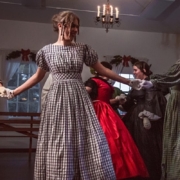Celebrating women’s history in Washington Territory
Fort Steilacoom Museum in Lakewood is honored to focus on the history of women in the early creation of Washington Territory through a series of three videos found on our YouTube channel.
The three videos illuminate the lives and activities of women who lived in Puget Sound in the 1840s, 1850s and 1860s. We hope the videos will be of particular value to living history re-enactors and anyone else interested in the details of Washington Territory history.
These are the three videos:
- “In Her Shoes: Tracing the Footsteps of Pierce County Women in the mid-1800s.” Historian Claire Keller-Scholz talks about girls and women who lived on the Puget Sound in the 1840s, 1850s and 1860s. Among the people you’ll hear about: Catherine Tumalt, daughter of a mother from the Chinook Tribe and Iroquois Tribe father who came to work for the English Hudson’s Bay Company in Puget Sound. It’s her picture that accompanies this post.
- “Women’s Work in Washington Territory.” Tacoma Historical Society’s Curator, Elizabeth Korsmo, talks about the day-to-day lives of women in the 1850’s to 1860’s. Korsmo talks about the typical employment during the time, as well as more unusual figures such as Kate Melville, Pierce County’s first female deputy sheriff.
- “Airing Your Dirty Laundry.” Historical interpreter Peggy Barchi shares detailed information about the daily grind that army laundresses endured and the skills it took to be one. You could earn 50 cents to a dollar a month for every soldier, but it was hard work hauling water as well as clothing.
Several women were employed as laundresses at Fort Steilacoom, the first official U.S. presence in Puget Sound. Fort Steilacoom, established in 1849 and closed in 1868, played a significant role in the settling of Washington Territory.
Another video, not part of the series but still valuable, is about the wives of August Kautz, the military officer who supervised construction of our buildings in 1857 and 1858. He married a member of the Nisqually Tribe, and their descendants still live in this area. You can watch that video here.
Our association acknowledges the complex history of the Fort and its role in the colonization of the area. We are actively working to incorporate the diverse perspectives and experiences of all individuals and communities who interacted with the Fort.




